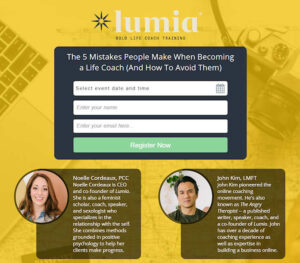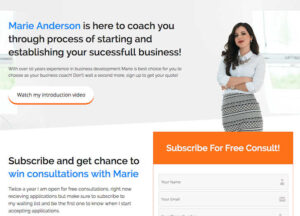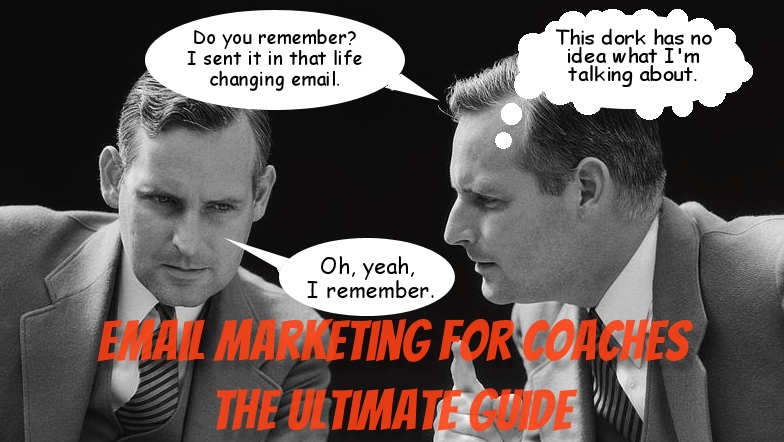Coaches, don’t try to hide it; you would love to use email marketing to promote your business and are drooling over the prospect of using it.
It’s not because, in 2020, 4 billion people were using email, and that number will grow to 4.5 billion by 2024 – is it? (Wink-wink.)
Are you ready to unlock the power of email and take your coaching business to new heights?
Fasten your seatbelt because today, we are diving into the magical inbox world of email marketing.
And the best part?
We will be exploring email marketing specifically for life coaches.
So, grab a cup of your favorite beverage, get cozy, and prepare to learn the art of email wizardry.
Let’s dive in, shall we?

Why Professional Life Coaches Need to Use Email Marketing
Before jumping into how to use email marketing for your coaching business, let’s explore why it would be smart for you to use it.
Build Your Credibility
First, email marketing will help your coaching business create and build relationships with your audience.
An example of this principle is Germany, which has the highest open rates of any country in the world (58.1%).
The industry average for open rates is 27%, but the Germans are all about familiarity.
In Germany, email marketers have to earn the trust of prospects and clients, or they are unsubscribed.
In the coaching industry, you need to remember that you are in the trust business, and the one way you can do that is by using email.
Email marketing will let you deliver valuable content regularly, earning the trust of your followers. Over time, you will develop a strong bond with them that is very valuable.

Target Your Audience with Email Marketing
Another reason why email marketing is excellent for life coaches is it will let you pinpoint your audience.
What do I mean by that?
You can break down your email list into different groups; the process is called segmenting. You can segment your subscribers based on interests, demographics, and geographic locations.
This makes it easy to make your email messages personalized and tailored to people on your list.
Not only will you be able to place their names into the emails, but you can also send them messages about what they’re interested in.
Email Marketing is Cheap…Or is it?
Many websites will tell you that email marketing is cheap, but this is not exactly true.
Sure, you can send an email for free, and it is far cheaper than a direct mail campaign or a billboard, but there are costs you must consider with an email campaign.
There are cost factors you must consider with email marketing.
First, there are email platform costs.
For 2023, an email hosting plan will run you $3 to $6 a month, and if you need more services from your email platform provider, you will pay more than $15.
Hey, it is not megabucks, but there is a monthly cost.
Busy life coaches or counselors, should outsource email tasks to a team or at least one person.
If you outsource to a team, you can expect to pay thousands. But if you can do the work, you can defray the costs. However, if your coaching business gets big enough, you will have to outsource, or you’ll work yourself to death.
What kind of work will need to be outsourced?
- Graphics
- Planning
- Copywriting
- Scheduling
- Troubleshooting
Yes, there are quite a few tasks involved.
Finally, there is one other resource that must be spent besides money: time.
You never want to buy email addresses, so you must cultivate them yourself. Once again, if you do not know how to set up an email opt-in box and create a lead magnet to get people to sign up for your subscriber list, you should hire somebody to do it for you.
Once you have all those assets in place to start cultivating email addresses, it will still take time to get subscribers.
Despite all the costs, email is still one of the cheapest marketing tools.
Here are a few stats for you to consider from Statista:
Email generates $36 for every $1 spent, meaning email marketing ROI is 3600%.
59% of marketers believe email is over twice as effective at generating leads than channels such as PPC and paid social media.
18% of companies achieve email marketing ROI greater than $70 per $1 invested.
As you can see, even though there are costs, there is value and incredible potential in using email marketing.

You’re a Life Coach – So Build That List
As a professional coach, you must have an email list of readers engaged in your messages. If you want to create a herd of followers who want to hire you for your services, you must stay connected with them.
An email list will allow you to communicate with them and provide content that is of value to them.
Once your subscribers can see your professionalism and commitment to excellence in your content, it is easy to sell them your services.
This section will show you how to do that, so let’s start building your money-making list.
Identifying Your Ideal Clients
If you use email marketing for your coaching services, you need to know who your target audience is.
What people will be the most interested in your programs, books, and services?
The way to figure this out is by understanding their needs, characteristics, preferences, fears, ambitions, and other factors.
One of the things I like to mention to life coaches is that they need to tightly define their market.
Example:
Too General: Success Coach
More Specific: Success Coach for Businessmen or Businesswomen
Even More Specific: Success Coach for Accounting Professionals
Very Specific: Success Coaching for CPAs and CFOs
When you tightly define your market, your marketing life becomes easy.
You know what kind of clients you are looking for
It will save you time creating marketing assets
You will not waste money marketing to a large group
It will be easier to specialize in one sector instead of many
I am not telling you that you must follow this model because you are the professional in charge of your business.
You may want to go wide and then narrow down to just a segment of the market. You can also start narrow and widen over time; it is all up to you.
Use Demographics
Once you’ve figured out what your coaching niche is, you should try to gather some demographics about your target market.
So, what constitutes a target demographic?
In marketing, businesses use demographics to identify and define their target customers. Demographics encompass the observable and significant characteristics of a specific group or population.
Some common examples of demographic information collected include:
- Age
- Gender
- Race or ethnicity
- Geographical location
- Educational attainment
- Occupation
- Income level
- Marital status
- Number of children
- Residential status (renter or homeowner)
Target markets contain individuals sharing the same interests or characteristics, which makes it easier for a coaching business to promote its services and products.

Identify Challenges and Problems
Personal life coaches can identify common challenges or problems in their target market through various methods. Here are a couple of ideas on how you can do that.
Market Research
You can gather information about a market by looking at industry assets, and almost every industry has reports, whitepapers, surveys, and focus groups you can access.
It may take some searching to find this information, but common industries usually have a group on LinkedIn, Quora, or Facebook, where you can ask someone where to find them.
Talk to Your Clients
If you have clients, you can talk to them about their challenges and obstacles, and these conversations can unravel marketing insights you may never have thought about. Also, don’t forget to reach out to past clients for information.
Network in your Industry
There’s a reason why life coaches attend events related to their business. You can get a lot of insider knowledge and ideas from going to them.
By joining conversations and sharing experiences with other professionals in your industry – it should be easy to gather vital information about the challenges your prospects and clients face.
Visit Online Communities and Forums
I mentioned this earlier, but you can use forums and communities where your target market hangs out. Lurk around and observe conversations, discussions, and ideas while paying attention to common problems and questions from members.
Your Personal Documents and Records
If you’ve had a coaching business for a while, I’m sure you’ve kept records of your clients, right? It would be easy to dig those assets out and look at past client interactions and problems raised by individuals you were trying to help.
Take notes about those challenges and keep a marketing record of them. Once you possess demographic information about your target market, you can develop marketing strategies to approach them while retaining and promoting more services and courses.
You Need to Create a Lead Magnet
If you need to build an email list for your coaching business, you will need a lead magnet to get subscribers.
What’s a lead magnet?
A lead magnet is content that entices people to give you their email addresses.
But where will you get your lead magnet from?
You can either make one yourself or hire someone to make it for you.
Now that you have a good idea of your target market, you should know their desires, pain points, and goals, and it will be easier to create something informative they can use. But before you start writing your butt off, or hiring a copywriter to make one for you, here are some things you need to consider.
It’s Proof You Can Coach
First, you must offer information of high value, and it should address problems your target audience has or show them how to fulfill a desire.
So, the whole idea behind a lead magnet is to provide your readers with value, and it must be enticing enough to get people to sign up for what you put out. Another purpose of having a lead magnet is it shows your followers you know how to coach.
In other words, it demonstrates your expertise and gives your readers confidence that you know what you are doing. In this context, a lead magnet can give you and your business a quick win because it proves you know how to coach people professionally.
Doing so will create a lasting impression that will stay in the minds of your audience and initiate a long-term relationship.
Give Your Lead Magnet Pizazz!
One thing many marketers don’t consider when they create a lead magnet is that they need to make it look professional. This is one reason you should hire a professional copywriter to craft a lead magnet.
A professional copywriter can help you make your lead magnet visually appealing, well-organized, and easy to read.
A good copywriter can:
- Use eye-catching graphics
- Make complex information simpler
- Write compelling titles and subheads
- Format writing for easier reading
- Use bullet points
- Organize the material in a logical manner
Your lead magnet needs to look highly polished and professional. First impressions are paramount in business, and you don’t want to drop the ball once you get an interested prospect’s attention.
Don’t Forget a CTA
You must have a Call to Action (CTA) in your lead magnet.
Why?
Because your lead magnet isn’t the banquet, it’s just the appetizer. Your magnet must move your herd toward the trough of your coaching services.
So, tell them the next step to take with a CTA.
Tell them to sign up for your newsletter, coaching club, or video channel or to contact you for a free consultation. As a matter of fact, almost every communication you have should have a well-crafted CTA in it.
I’m not saying you should send out email messages that are sales letters, but if you send out informative emails, mention your services and products.
(A good email copywriter will know how to do this subtly.)
Creating an eye-popping, informative lead magnet will help you attract the prospects you need for your coaching business.
Lead Magnet Ideas for Life Coaching Businesses
Most life coaches use eBooks as lead magnets, which isn’t a bad idea.
However, there are different kinds of lead magnets to create for your business.
Here is a list of different lead magnets you can use:
- Guides and reports
- Cheat sheets
- Tool kits and templates
- Videos
- Free trials
- Discounts to coached events
- Free consultations with analysis
- Assessments or Quizzes
- Checklists and Cheat sheets
- Workbooks and frameworks
- 7-day challenge (You determine the number of days)
- Guides
- Webinars
- Access to a resource library
If you put some quality effort and thought into it, you will have a lead magnet that will bring in prospects and email subscribers for years.

Build a Lead Generating Landing Page
Life coaches, if you are going to have a successful business, you must have a professional online presence. To do that, you will need an optimized website that displays your professionalism.
Your site will also need a well-crafted landing page that prospects can come to. Once they are on your landing page, your copy should be able to entice them to sign up for your email list.
I’ve mentioned defining your target audience several times during this post, but it is worth repeating. When you build your landing page, you must know your audience’s needs, pain points, and preferences. Everything on your landing page must guide your readers to sign up for your content. So, keep that in mind as you are going through this process.
Create a Compelling Value Proposition
Before promoting your website, you need to craft a persuasive value proposition. A good value proposition displays the unique benefits you can give your coaching clients. A good thing to do is place your value proposition in a prominent place on your landing page. It should be placed where it can be immediately seen and read.
The proposition should express how your coaching services can help them achieve their goals and what they can expect from you, and the page should also entice your visitors to visit other parts of your website.
You Are Going to Need a Landing Page
Landing pages can be powerful tools for professional life coaches. Having a dedicated landing page focused on a specific coaching program or service you are trying to promote is a good idea. If you decide to build one, keep the design clean and visually appealing while communicating your service’s benefits.
Try to include a call-to-action CTA encouraging visitors to take the next step, like signing up for your lead magnet.
Use Forms to Gather Email Addresses
If you want to use email marketing for your coaching business, you should use lead capture forms. (Also called Opt-In boxes.)
Lead capture forms are excellent tools for building your email list and nurturing relationships with potential clients. In this section, I will show you how to effectively use them to grow your email list.
First, choose an email marketing platform that aligns with your budget and needs. Back in the early days of the internet, you had to buy software to load codes into your site, but now all you have to do is subscribe to an online service to get the job done.
Popular platforms for email marketing are:
- MailChimp
- ConvertKit
- Aweber
- Constant Contact
If you are new to using these platforms, you can access their websites and learn how they work, and each of these email platform sites has a YouTube channel, so you can watch videos on how they work.
Ignite Your Platform
Once you have decided on the platform you want to use, the next step is signing up for your account. Most email service companies have an easy sign-up process built into their sites, so signing up is easy. All you will have to do is sign up for the registration process and provide them with the necessary information they need.
Set Up Your Email
Once you set up your account, it is time to set up your email list. Once again, the company you have selected will talk you through the process. One task you will have is to give your email account a name that your readers can identify with. Your platform will also ask you to segment your list, but you don’t have to do that immediately.
Generate and Install an Opt-In Box
Your platform will give you tools to create a form to collect email addresses. Using the form builder in most email sites is easy, and you can design your form to match your website’s landing page.
One important copywriting tip you should know is to have a call to action on your form. Just like the copy on advertisements and sales letters, you must tell your readers how to take the next step.
The best way to learn how to create a winning opt-in box is by swiping ideas from successful coaching sites.
Here are a few ideas to help you understand what good a good opt-in pages and CTAs look like:


Once you’ve crafted your opt-in box, copy the code and drop it into your landing page. If you are using a WordPress site, you can use a plugin to install a sign-up box into one of your pages easily.
Test Your Opt-In Box
Before you go live with your form, test it to see if it’s working properly. You can do this by trying it out with a secondary email you have and getting family and friends to use it too.
Start Sending Valuable Email Messages
Life coaches should send emails that build trust, nurture relationships, and provide value. Below, I’m giving you a rundown of the kinds of email messages to send out to your followers. I know it looks like a lot, but you’ll get used to these different kinds of emails over time.
The Welcome Email
The first kind of email message life coaches should use is a welcome email. This email is written specifically for new subscribers. All you have to write in a welcome email is the following:
A personalized, warm email that introduces yourself while expressing gratitude for your interest in your services.
Tell them the kind of valuable content you will be sending them.
A preview of what your messages will bring.
A Call to Action (CTA) telling them to watch for your next email messages.
Motivational and Inspirational Messages
Share uplifting and inspirational messages to your subscribers that offer encouragement, personal stories, and tales of success others have achieved.
These messages should motivate them to take action to get them started on their own journey.
Educational Content
Life coaches should provide valuable content that educates readers and helps them immediately improve their lives. Educational messages should share tips, strategies, and techniques essential to personal growth.
Actionable Exercises and Steps
Your readers will crave direction from you, so give it to them by sending them actionable steps they can use right away. Show them how to overcome obstacles, challenges and develop helpful habits to achieve their goals.
Case Studies
Case studies are powerful because they give the reader the idea that if someone else accomplished a dream, they could do it too. Share real-life examples of past clients or people who have transformed their lives and reached the pinnacle of success.
Also, if your coaching was a part of someone’s success, make sure you crow about it.
Question and Answer Emails
This is also known as Ask Me Anything (AMA) Emails. In these messages, you will encourage your readers to send in questions or topics they would like you to answer, and the reason why they work so well is it fosters engagement between you and your audience.
Allowing clients and prospects to communicate with you personally is very important to a life coaching business.
Events and Workshop Announcements
Life coaches conduct regular events and workshops and keep their subscribers informed about upcoming events, so it would be a good idea to tell your readers about webinars, seminars, and workshops you will be hosting.
Send your list emails announcing these events and give them a good CTA telling them to sign up.
Important Recommended Resources
It’s a good idea to share articles, videos, podcasts, and books valuable to your followers. ( Of course, you can also create your own, increasing your authority in your niche.) Directing your readers to high-value resources shows you are knowledgeable in the personal growth and development department.
Testimonials From Past Clients
If you have clients who are happy with the services you provide them or benefit from your coaching, use their testimonials.
Share their transformations and experiences and explain how your coaching impacted their lives in your email messages. Displaying social proof is huge in building trust and credibility with clients and prospects, so don’t ignore it.
Exclusive Promotional and Offers
Provide discounts and offers to your coaching services, products, and programs and make them exclusive to your subscribers. You want to create a community of followers for your business, and discounted promotions will reward your subscribers for sticking with you.
Life coaches should make these email messages as personal as possible, and there are two ways you can do this.
First, you need to personalize your messages, and you can do this easily by using the tools your email platform provides. Adding names to your emails is easy, and your email platform will have videos or a page explaining the process.
Also, you will need to tailor your emails to the specific needs and goals of your audience. The way to do that is by segmenting, and your platform can also show you how that works.
(It would take another 4000 words to explain segmenting, but you can read about it here: Mailchimp’s Segmenting Page)

My Insane Addiction to Email Subscriptions
Now that you have an honest and more objective view of using email marketing in your coaching business – let’s go into more detail.
The main focus of this post is to help you decide (as a professional coach) whether email marketing will help you increase your bottom line.
Right?
Before I sign out with my conclusion, I want to tell you about my email-hoarding addiction.
Yes, I have an addiction to subscribing to email lists. But not just any old email list; I subscribe to email lists of top-dog coaches.
Over the last several years, I’ve been sniffing around the websites of successful life coaches and subscribing to their email lists.
If I know a success coach or a life coach with a thriving business, I’ll sign up for their email newsletters.
Why?
First, I want to read what they have been sending people because there is a lot a copywriter can learn from reading well-written email messages.
Second, I’m looking for validation; I want proof that email marketing is a way life coaches can connect with clients and prospects successfully.
Tony Robbins, Bob Proctor, Jack Canfield, and Marie Forleo use email marketing for their multimillion-dollar coaching businesses.
I’m so bad about this addiction that I have about 5 to 10 throwaway email accounts that I use. If I used my personal account, it would be flooded overnight.
So, when I’m forking over advice about how you should use email marketing in your mix, it’s not like I’m just pulling ideas out of my butt.
I’ve taken the time to check things out, capiche?
But the bottom line is: start collecting emails from successful life coaches. Subscribe to their newsletters and email messages and find out what they are doing. And bear in mind, if they are successful at their businesses then you need to learn everything about their marketing systems.
Conclusion
I know this was a long post on how life coaches can use email marketing, but it could have been longer. In the past year I’ve written several extensive posts on how coaches and other businesses can use email to sell their products and services. You can always go to my massive blog and check out those posts.
One last thing, get started. The world is full of people who take courses and listen to all kinds of advice, but don’t take action. Take action right now and follow the steps above, it might change your life.
If you got valuable information from this post, please leave a comment, it would really make my day.


Elmo, thank you so much for this step by step guide to email marketing. I appreciate how thorough it is and love the fact that you shared visual examples of what a successful landing page and ‘Opt-in’ boxes look could look like.
I am definitely one of those people who study, study, study, so I also thank you for the essential reminder to take action.
Jacqueline, thank you so much for your kind words. If there is anything I can do to help you, please let me know. God Bless!